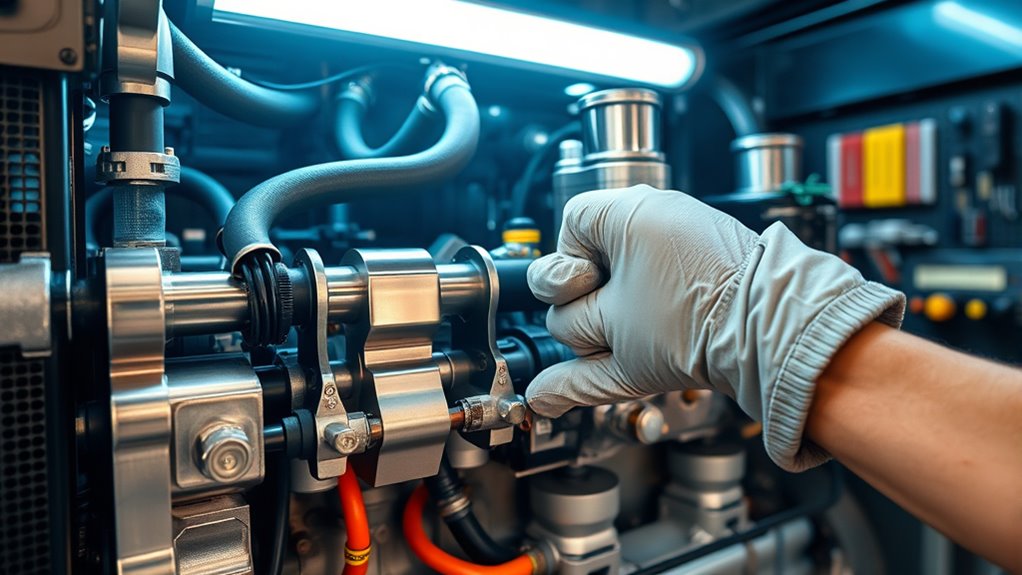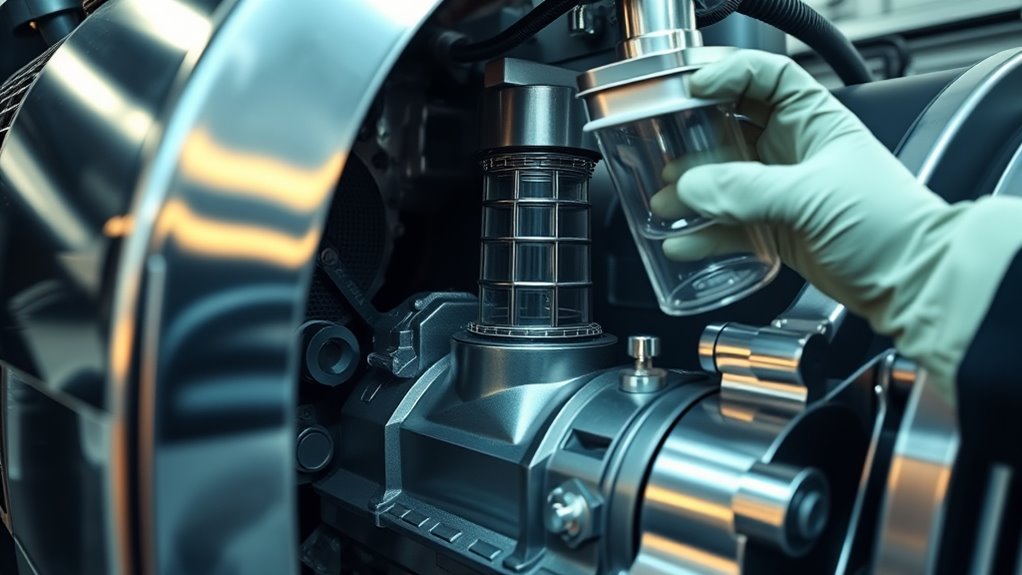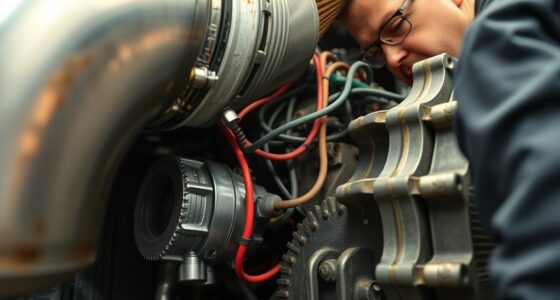To prevent wet stacking in diesel generators, avoid running at very low loads for extended periods, as this cools the engine and causes unburned fuel buildup. Use high-quality fuel and keep fuel injectors and filters clean to guarantee complete combustion. Manage operating temperatures by operating closer to recommended loads and inspecting exhaust systems regularly. Monitoring exhaust gases can help detect issues early. Keep in mind, proper temperature control and maintenance are key—learn more to keep your generator running smoothly.
Key Takeaways
- Operate the generator at recommended loads to maintain proper engine temperature and ensure complete combustion.
- Use high-quality diesel fuel to reduce contaminants and sulfur that contribute to unburned fuel buildup.
- Regularly inspect and clean fuel injectors and air filters to promote efficient fuel delivery and airflow.
- Monitor exhaust emissions with analyzers to detect incomplete combustion and address issues promptly.
- Perform routine maintenance on exhaust systems and keep engine temperatures optimal to prevent wet stacking.

Wet stacking occurs when a diesel generator operates at low loads for extended periods, causing unburned fuel to accumulate in the exhaust system. This buildup results in excess fuel not being burned efficiently, leading to increased exhaust emissions and potential damage to your generator. To prevent this, you need to pay close attention to fuel quality. Using high-quality diesel ensures complete combustion, reducing the likelihood of unburned fuel lingering in the system. Poor-quality fuel often contains contaminants or excessive sulfur, which can impair combustion efficiency and promote wet stacking. Always source your fuel from reputable suppliers and consider adding fuel additives designed to improve combustion and clean fuel injectors, further minimizing the risk.
Another vital aspect is managing your generator’s operating load. Running at very low loads for long durations causes the engine to run cooler and not reach ideal operating temperatures, which hampers complete fuel combustion. This incomplete combustion results in unburned fuel passing through the system and accumulating in the exhaust. To combat this, operate your generator closer to its recommended load capacity whenever possible. If the load is consistently low, consider running the generator at a higher load for short periods to raise the engine temperature and promote complete burning of fuel. Regularly scheduled load testing can also help maintain proper combustion conditions and prevent wet stacking.
Monitoring exhaust emissions is essential for early detection of wet stacking. Elevated levels of hydrocarbons and carbon monoxide in your exhaust indicate that combustion isn’t complete. Installing exhaust gas analyzers can help you keep an eye on these emissions, alerting you to potential issues before they cause significant damage. Maintaining proper maintenance routines—such as checking and cleaning fuel injectors, air filters, and exhaust systems—also plays a vital role. A clogged air filter reduces airflow, leading to poor combustion, while dirty injectors can cause uneven fuel delivery, both of which contribute to wet stacking. Keeping these components clean and functioning at their best helps ensure complete combustion, reduces emissions, and minimizes unburned fuel buildup. Additionally, understanding the role of temperature control in your generator’s operation can help optimize combustion efficiency and prevent wet stacking issues.
Frequently Asked Questions
How Does Ambient Temperature Affect Wet Stacking?
Higher ambient temperatures can diminish your diesel generator’s cooling efficiency, leading to increased risk of wet stacking. When it’s hot, ambient humidity often rises, which hampers heat dissipation. As a result, unburned fuel can accumulate in the exhaust system. To prevent wet stacking, you should monitor ambient temperature and humidity levels, guarantee proper cooling, and run the generator at ideal loads, especially during hot weather, to maintain efficient combustion.
Can Fuel Additives Eliminate Wet Stacking Issues?
Fuel additives can help reduce wet stacking, but they don’t completely eliminate the issue. Look for additive formulations that improve fuel stability, preventing fuel degradation and carbon buildup. These additives enhance combustion efficiency, especially during low load or infrequent use, by maintaining cleaner injectors and combustion chambers. While beneficial, you should also monitor other factors like load management and maintenance to fully prevent wet stacking.
What Are the Signs of Wet Stacking in a Diesel Generator?
You’ll notice wet stacking signs like black smoke, excessive fuel consumption, or a rough engine idle. Poor fuel quality can cause incomplete combustion, leading to unburned fuel building up in the exhaust. This reduces combustion efficiency, making your generator run inefficiently and increasing emissions. Regularly checking exhaust smoke and engine performance helps catch wet stacking early, so you can address fuel or combustion issues before they cause damage.
Does Generator Size Influence Wet Stacking Risk?
Think of your generator as a finely tuned instrument—its size does matter. A larger generator capacity can handle higher loads more efficiently, reducing wet stacking risks. Proper load management guarantees it’s not running underloaded or overloaded, which can cause fuel to burn improperly. Smaller units are more prone to wet stacking if not matched to your load demands. So, choose the right size and keep load management in check to keep your generator running smoothly.
How Often Should Maintenance Be Performed to Prevent Wet Stacking?
You should perform maintenance regularly, ideally every 250 to 500 operating hours, to prevent wet stacking. During each service, check fuel quality to guarantee it’s clean and free of contaminants, which can contribute to incomplete combustion. Additionally, optimize engine tuning—adjusting fuel settings and airflow—so your generator runs efficiently. Proper maintenance keeps your generator running smoothly, reduces carbon buildup, and minimizes wet stacking risks over time.
Conclusion
By preventing wet stacking, you keep your diesel generator running efficiently, saving fuel and reducing emissions. But neglecting maintenance, like ignoring signs of wet stacking, can lead to costly repairs and environmental harm. It’s a reminder that careful operation isn’t just about machinery—it’s about responsibility. In avoiding wet stacking, you preserve both your equipment’s longevity and the environment’s health, proving that proactive care isn’t just smart; it’s essential for sustainable power.









